The hype for “growth at all costs” has died down in the last year. Budget freezes across organizations have pushed leaders to drive efficiency with the resources at hand.
Now, it’s all about doing more with less. And the concept is quickly gaining ground among leaders because they can drive efficient growth by keeping costs low.
But how exactly are they doing it? And is it efficient enough with limited funds?
Those are the questions we sought answers to in our conversation with Eric Welsh. Eric is the Director of RevOps at Demostack and has been in RevOps and its adjacent spaces for nearly a decade.
This blog digs into his wealth of experience to bring you insightful nuggets for driving efficient growth. You can also view the full conversation below.
Defining Efficient Growth for Businesses Today
We’ve witnessed, in the last few years, that market conditions can change instantly. At the same time, aggressive growth encouraged companies to raise funds, invest, hire, and innovate quickly.
But when following an efficient growth mindset, the primary question you need to ask yourself is—are you growing in a way that constantly needs funds to survive and thrive?
And if the answer’s “yes,” your growth isn’t efficient.

Instead of solely focusing on raising funds, your goals must adapt to the evolving business environment. That means you should be able to drive efficient growth even when the funds dry up with the resources you have so far in your journey.
It begins with paying attention to early cost warnings, allocating and reallocating resources as needed, and facilitating transformational growth (as opposed to just rapid growth).
You need to push for cleaner, more transparent, and standardized process flows that avoid a lag in scaling. It also means you may have to turn to digitization and automation to maximize your resources.
What Makes Revops the Perfect Choice to Drive Efficient Growth?
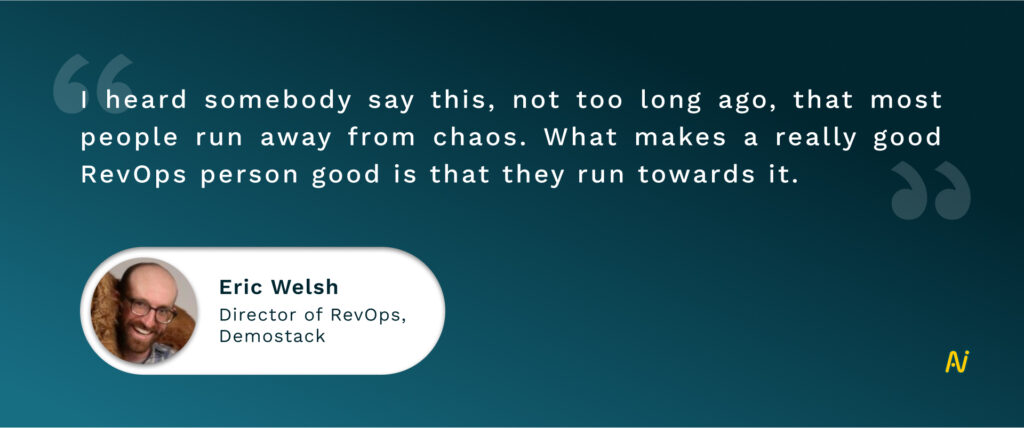
Revenue operations or RevOps is an end-to-end operating model that helps organizations run their business in an interconnected way across GTM functions like sales, marketing and customer success.
The function’s primary responsibility is driving visibility and accountability among leaders, stakeholders, and teams to:
- Identify new opportunities
- Improve win rate and conversions
- Plug data and revenue leaks
- Optimize workflows and processes
- Boost profitability
- Refine the customer experience
As Eric points out, RevOps is based on 4 key pillars—Process, Data, Platforms, and People.
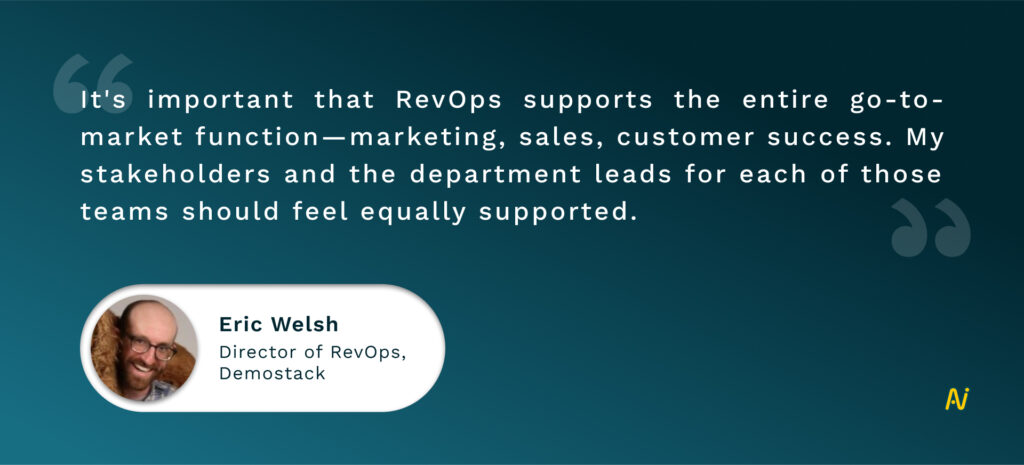
Given that it advocates and strives for efficiency in every single action, it’s no wonder the function is becoming increasingly popular for businesses:
- B2B companies investing in RevOps have experienced 10-20% increases in sales productivity. If your reps are productive, your revenue process is more efficient and has a better chance of succeeding.
- Leadership positions in RevOps topped the list of fastest-growing job titles in the US this year. And Gartner predicts that 75% of the highest-growth businesses globally will deploy a RevOps model by 2025.
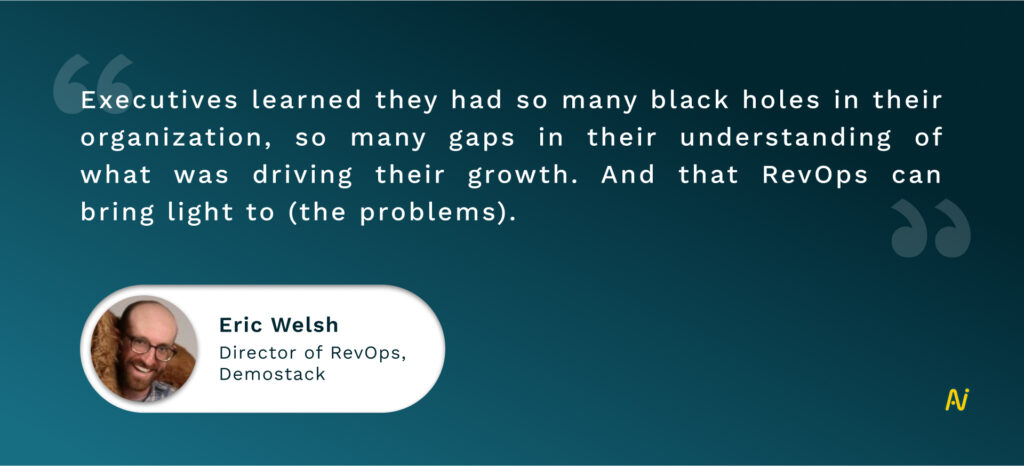
RevOps moves beyond a conventional approach that segments individual teams. Instead, it strives to create balance, better communication, and collaboration among functions—bringing them together.
The result? It maximizes your revenue while simultaneously minimizing costs.
Problems That Revops Solves for Today’s Efficiency-Focused Businesses
Businesses face prevailing challenges that snowball into revenue leaks and inefficiency. Here are 3 key challenges that could affect efficient growth.
1. Buyers Want More, but Are You Ready for It?
85% of sales reps met or exceeded their sales goals in 2021. That number dropped a little in 2022 to 82%. While that may seem like a small figure, it’s a big jump in 12 months.
The underlying cause is that buyers want more, but not all sellers can live up to these expectations.
Buyers want more solution-based pitches showing how the product aligns with their use cases. But your reps may focus on the old-fashioned product approach (which comes across as more sales-y).
Customers also want sellers to personalize their pitches and have more interactions to discuss the solution. In comparison, reps may be caught up with finishing non-selling tasks and filling up the pipeline.
A lack of effort and understanding at the rep’s end could cost you a long-term customer.
2. Pipeline Visibility Is Poor
As much as 71% of revenue professionals report that their marketing, sales, and customer success functions are not fully aligned. That translates into a lack of visibility into the customer journey through the sales pipeline.
Poor quality data is to blame here, primarily data that remains stuck in silos between revenue teams. If they don’t have access to complete and accurate data across the funnel, they can’t talk to each other and exchange information. Subsequently, you miss profitable opportunities.
3. Inaccurate Predictions Slide Into Forecasts
16% of salespeople attribute unrealistic quotas as one of the top reasons for sales job turnover. But where do these unrealistic quotas come from?
Inaccurate forecasts.
As much as 80% of organizations don’t have a forecast accuracy greater than 75%.
To sum it up, inaccurate forecasts cost you earnings and employees. In the larger scheme of things, this may also ruin your reputation among customers and job seekers alike.
Faced with the above 3 challenges and limited funds, businesses are now looking to invest in solutions that are hard-wired for efficiency. Subsequently, this efficiency evolves into effective revenue growth.
We’ll see, in more detail, how RevOps has massive potential to drive efficient growth and business profitability.
How Revops Drives Efficient Growth for Businesses
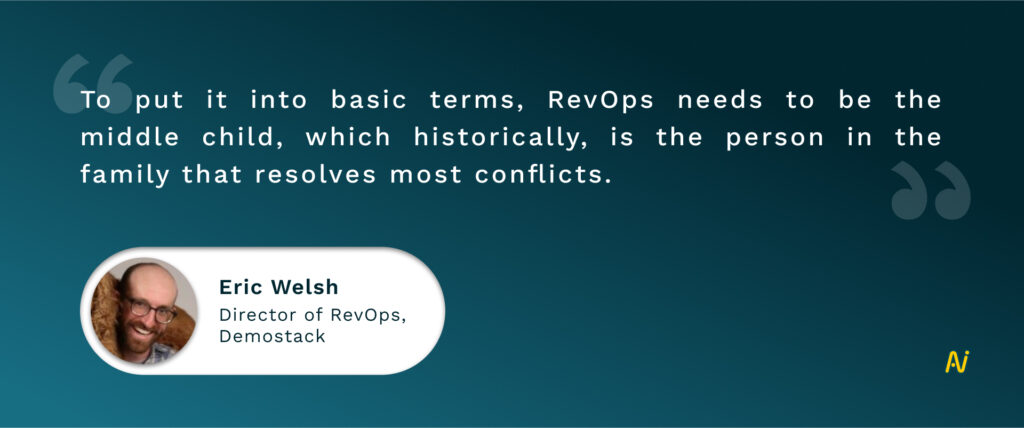
Eric sums up RevOps’s purpose so clearly. It’s the problem-solver, troubleshooter, and growth-focused sibling of all operations functions.
This ability to solve problems and do it with resources at hand is what makes RevOps a frontrunner for navigating efficient growth.
Here are 8 ways RevOps can help:
- Data hygiene & orchestration
- Refined alignment
- Streamlined tech stack
- Better forecasting
- Leadership buy-in
- Consistent performance tracking
- Improved rep productivity
- Happy customers
Let’s dive into each one of them below.
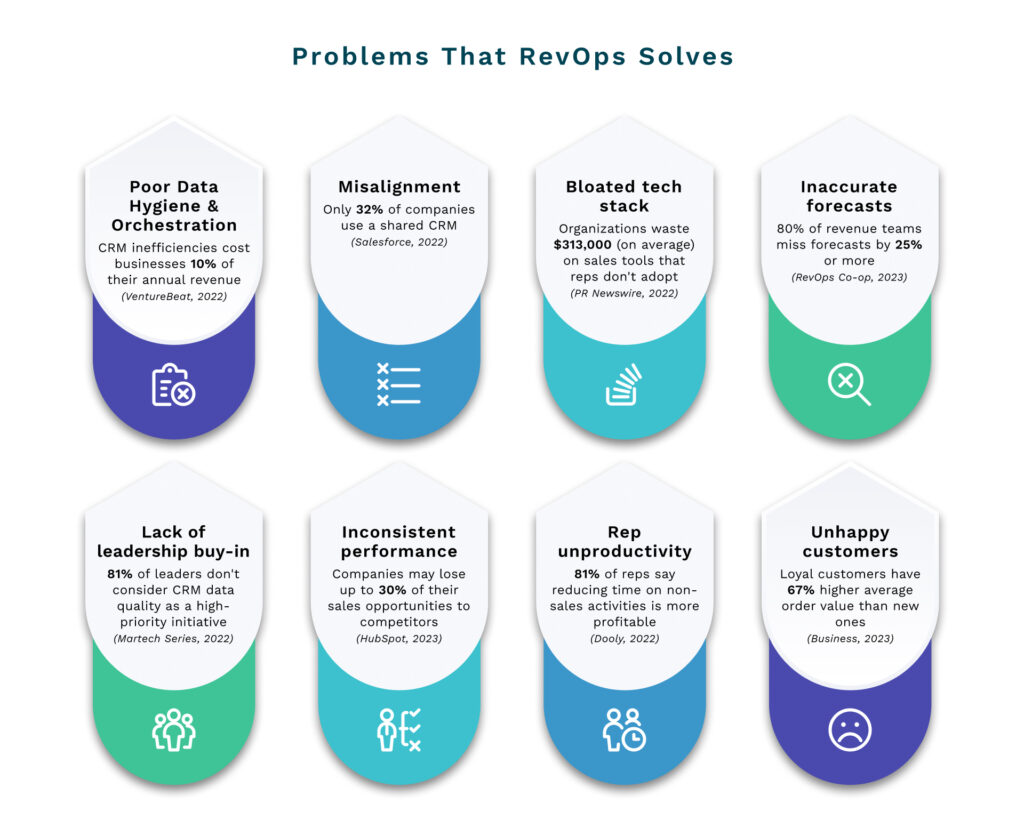
1. Data Hygiene & Orchestration
You can make the most of data when you focus on the quality rather than the quantity in the CRM. Having tons of data is excellent, but all your efforts will lead to disappointment if you can’t make business decisions from it.
Dirty data can turn your revenue growth efforts upside down like this:
- Inefficiencies in the CRM can cost businesses as high as 10% of their annual revenue.
- 95% of CRM users say poor data quality critically affects their ability to leverage the CRM.
- Data inefficiencies cause B2B businesses to miss 70,000+ sales opportunities each year.
Those are some damning numbers, particularly when you’re trying so hard to scale.
RevOps takes the dirty data problem head-on by setting up a data hygiene strategy. It enriches the CRM with clean and complete data.
This strategy is also a solid roadmap to generating actionable insights from the CRM by:
- Understanding use cases
- Planning configurations
- Updating processes
- Implementing tools for the tech stack
- Sales enablement
The best step that RevOps takes to clean data is conducting regular data audits, building a governance framework, and orchestrating data. It checks data rule breakers and prevents them from happening again.
It also defines data quality metrics, validation rules, data ownership responsibilities, and data management.
Manual data entry is also a significant contributor to poor-quality data. RevOps can do away with it by automating it and making reps’ lives easier. This action maintains data integrity and prevents it from becoming a classic case of “garbage in, garbage out.”
Instead, clean and complete data becomes the solid foundation for making informed decisions and contributing to efficient growth.
2. Refined Alignment
You can claim your teams are aligned when four key pillars—process, people, tech, and data—follow a common data language and framework. And guess what RevOps is based on? These exact four pillars.
Silos no longer work because the buying process is complex and multiple stakeholders are involved. Plus, the customer journey is non-linear, meaning customers could reach you through various channels (as opposed to a single channel—sales reps).
RevOps breaks down silos between teams. Maintaining a unified view of each customer’s journey is vital. Alignment is what creates a singular view of customers.
Multi-functional teams are 14% more likely to provide an unparalleled buying experience when they use a shared CRM. Alas, only 32% of companies have this in place.
So, how does RevOps align teams?
- It pushes revenue teams to assign shared goals (alongside individual team goals).
- Teams must also follow a common data language and framework.
- RevOps also sets rhythms of the business or cadences for communication, team meetings, reviews, and operations.
It sounds utterly simple, yet businesses fail to do this without RevOps.
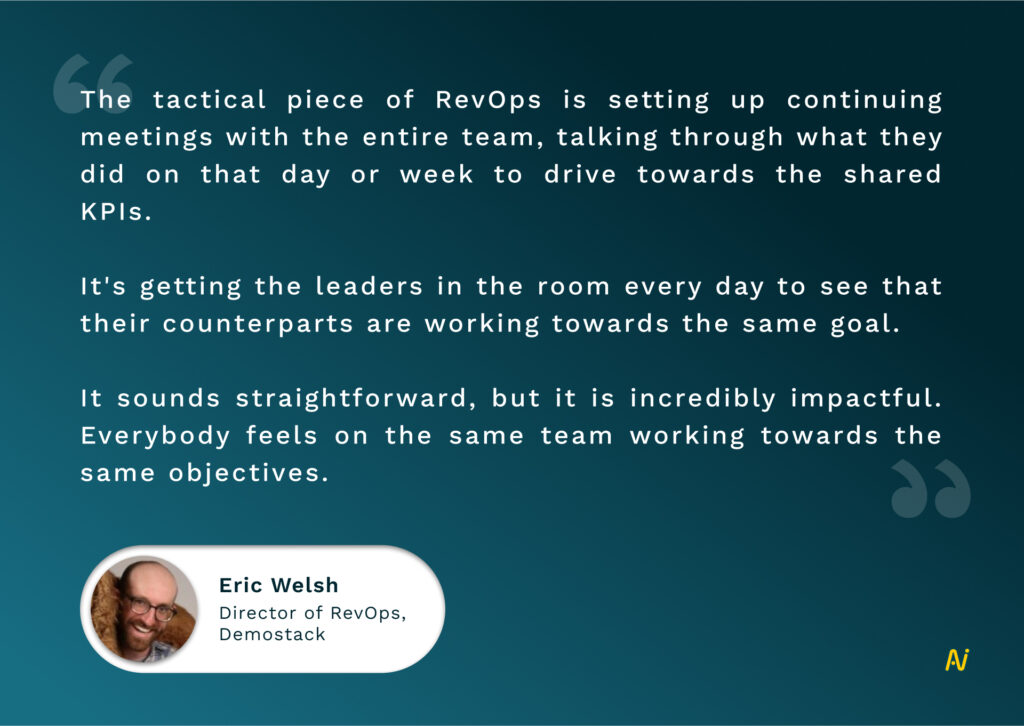
RevOps syncs your systems by defining the customer lifecycle, layering it with KPIs, and establishing a systems view. Then, it ties all this together with an interlocking cadence. It streamlines marketing, sales, and customer success for frictionless handoffs.
Ultimately, RevOps brings together all teams to ensure they contribute equally toward business growth.
3. Streamlined Tech Stack
Fragmented data across the tech stack restricts customer experience, prioritization of actions, handoffs between teams, and insights-sharing.
RevOps orchestrates data, making it accessible across the tech stack to all teams. It changes how data is shared so crucial insights don’t stay stuck in adjacent tools but flow into the CRM. These tools include inboxes, calendars, meeting notes, calls, and more.
You can also enable your teams to create (a) an end-to-end experience for buyers and (b) a unified pipeline view for sellers.

You can accurately segment your audience and target each with relevant content based on their position in the journey.
What’s more on the list?
- A more efficient tech stack backed by simplified processes
- Automation that structures raw data, maps complex business relationships, detects pre-engaged contacts, predicts churn, ensures data security, and reduces manual efforts.
- Reduction in tech debt by minimizing shadow tech stacks
4. Better Forecasting
Forecasts show you everything you need to know about how your business and industry grow. They also give you the basis for establishing benchmarks and channeling a proactive approach to changes.
One essential action that RevOps takes is improving forecast accuracy.
That’s because most teams struggle with incorrect forecasting. 80% of them miss their forecasts by 25% or more. In business terms, that may translate to thousands of dollars lost.
RevOps automates the forecasting process. Instead of going down the traditional route of using spreadsheets for forecasting, it takes the help of tech. These tools give more efficient, reliable, and accurate forecasts than manually-designed spreadsheets.
Revenue tech helps you:
- Keep a strong pulse on real-time situations
- Regularly update insights
- Monitor deal health
- Suggest actions for refining the selling approach.
Backed by this data-driven and reliable information, you can develop leading indicators. Leading indicators guide you to take measures for allocating and reallocating resources, pushing for more wins.
5. Leadership Buy-in
If you’re striving so hard to drive efficient growth, getting support from executives on the strategy board will only give you that much-needed impetus.
Leadership buy-in facilitates a long-term, strategic approach to scalability rather than short-term solutions that only show success in spurts.
Yet, getting leadership buy-in is a huge challenge. As much as 81% of leaders don’t consider CRM data quality as a high-priority initiative.
That’s because leaders get behind processes that have measurable impact. Support will be hard to come by unless you can prove this in numbers.
But RevOps tackles that to get leadership buy-in and a seat at the strategy table. There’s no going back once you prove how RevOps directly impacts revenue growth. It gives you everything you need to build compelling use cases and demonstrate the benefits of your strategy.
Leaders get to see the business value end-to-end with a holistic, bird’s eye view. It gives them a unique advantage of not missing out on critical situations and making informed decisions whenever faced with one.
Plus, RevOps acts as the bridge between teams and leaders:
- It provides complete visibility on GTM activities and business goals for teams
- It gives leaders the means to be in touch with their teams in real-time
By focusing firmly on the big picture—overall business goals and the customer lifecycle—, RevOps drives revenue growth, even for leaders.
6. Consistent Performance Tracking
Companies may lose up to 30% of their sales opportunities to competitors.
That’s a considerable margin, and it shows how crucial it is to assess where your business lags and the actions you can take to enhance sales processes, marketing techniques, and product offerings.
This is where tracking your performance comes into play. Metrics and KPIs show you which questions you need to ask to make changes and improve growth.
RevOps consistently monitors metrics and KPIs to:
- Bring you a clear picture of the entire revenue process
- Identify where the bottlenecks lie
- Develop optimization strategies to unclog the bottlenecks
- Improve accountability and transparency with leaders and teams
- Align teams to shared revenue and business goals
RevOps uses these measures to break down big business goals into smaller, actionable parts for your teams. The Objectives & Key Results (OKRs) technique is popular for measuring performance. It measures the results and ties them back to the main goals.
Some key metrics or KPIs you must measure are
- Monthly and Annual Recurring Revenue (MRR, ARR)
- Customer Lifetime Value (LTV)
- Net Retention Rate (NRR)
- Customer Acquisition Cost (CAC)
- Average Contract Value (ACV)
- Average Revenue Per User (ARPU)
- Win rate
- Conversion rate
- Customer Churn
- Renewal rate
- Quota attainment
- Time To Value (TTV)
But RevOps doesn’t just show you which metrics to measure. It also steers you away from vanity metrics like opportunities created, email open rates, website page views, social engagement, and more. These metrics don’t add measurable value to your revenue goals.
You can refine your performance by monitoring the entire customer lifecycle with revenue operations.
7. Improved Rep Productivity
Rep productivity is a vital cog in the revenue growth wheel. When reps are efficient, you can effectively:
- Optimize resources
- Refine performance
- Improve forecasting
- Adapt to changes faster
- Improve customer experience
Even reps agree. 81% of reps feel that reducing their time on non-sales activities may be more profitable for their company.
RevOps diligently works to eliminate areas of inefficiency and low impact through granular insights, such as—leveraging sales channels more effectively and assigning reps to territories based on their skill sets.
Eric provides a good example of how RevOps works with sales reps:
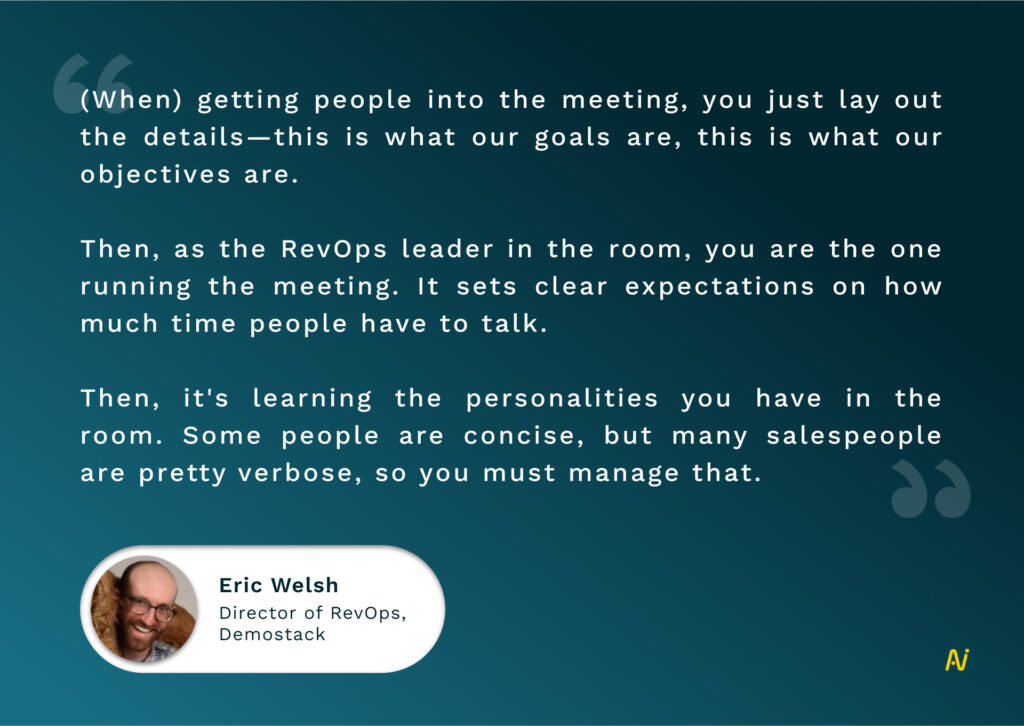
You also get leading indicators, real-time feedback, and visibility into high-intent deals. Leading indicators let you evaluate sales processes and performances more critically, creating meaningful coaching opportunities.
Better coaching equals selling processes equals better customer experience.
Reps can refine and personalize their approach to buyers. They can multithread with multiple stakeholders in the buying committee. Plus, they know which deals to prioritize.
What these leading indicators also do is give you more flexibility to adapt to changing conditions by monitoring:
- Trends
- Competition
- Customer behavior
Improving rep productivity with RevOps has multifold benefits, ultimately helping you build repeatable, winning sales actions.
8. Happy Customers
Happy customers—the singular factor that helps businesses continually scale.
Loyal customers are also profitable, having a 67% higher average order value than new customers. If you want to scale sustainably and with limited resources, focus on making current customers happier.
It mainly helps when new demand is low, but the pressure to keep revenue afloat is high.
Conventional business operations were a support function. But RevOps moves into a more strategic role, getting right into the thick of things. It’s designed to be obsessed with customer experience, making it critical to improve your retention rate.
RevOps makes buyers happy, creating frictionless buying journeys from contact to conversion, implementation, and, finally, renewal. It does so by:
- Breaking down tech and data silos
- Aligning teams
- Streamlining the revenue tech stack
- Automating repetitive tasks
- Tracking granular customer insights
As a result of RevOps, you can engage with customers throughout their lifecycle, address their use cases and continue creating value.
Grow Your Business With Complete Pipeline Visibility
RevOps transforms your pipeline into a well-oiled funnel. But it needs clean data to maintain complete visibility and run smoothly.
Nektar’s activity and contact data capture ensures you have clean, enriched data to drive predictable and efficient growth.
With this, you can:
- Unify revenue data
- Uncover missing or hidden opportunities
- Keep your CRM pristine
- Plug revenue leaks
- Have accurate forecasts
- Get leading indicators to coach reps
- Move deals from lead to cash faster
- Align cross-functional teams seamlessly
To learn more about our capabilities, contact us and see Nektar in action.







